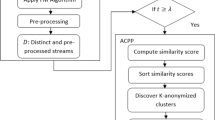Abstract
With the RFID data collection, it is an important data collection that is proposed to utilize in applications such as smart farms, healthcares, and transportations. Aside from these applications, it can also be utilized by data analysts. With such a data utilization of the RFID data collection, it can lead to being privacy violation issues. To address these issues, LKC-Privacy is proposed. That is, before trajectory datasets are released for public use, all at-most-L-unique subsequence paths are suppressed to be at least K indistinguishable paths, such that all protected sensitive values are related to every indistinguishable subsequence path; they have the probability of successful re-identifications to be at most C. Although LKC-Privacy can address privacy violation issues in RFID data collection, it often leads to being the issue of more information losses and more using execution time. To rid these vulnerabilities of LKC-Privacy, a new privacy preservation model is proposed in this work, such that it is also based on LKC-Privacy constraints. Moreover, the proposed model is evaluated by extensive experiments. From the experimental results, they show that the proposed model is highly effective and efficient than LKC-Privacy.




Similar content being viewed by others
References
Aggarwal C. VLDB Endowment, on k-anonymity and the curse of dimensionality. VLDB. 2005;5:901–9.
Chen R, Fung B, Mohammed N, Desai B, Wang, K. Privacy-preserving trajectory data publishing by local suppression. Information Sciences. 2011. https://doi.org/10.1016/j.ins.2011.07.035 (ISCI 231).
Ferrag MA, Maglaras LA, Janicke H, Jiang J, Shu L. A systematic review of data protection and privacy preservation schemes for smart grid communications. Sustain Cities Soc. 2018;38:806–35. https://doi.org/10.1016/j.scs.2017.12.041.
Fung BCM, Cao M, Desai BC, Xu H. Privacy protection for rfid data. In: Proceedings of the 2009 ACM symposium on applied computing, SAC ’09, pp. 1528–1535. Association for Computing Machinery, New York. 2009. https://doi.org/10.1145/1529282.1529626.
Juels A. Rfid security and privacy: a research survey. IEEE J Sel Areas Commun. 2006;24(2):381–94.
Khan F, Ur Rehman A, Zheng J, Jan MA, Alam M. Mobile crowdsensing: a survey on privacy-preservation, task management, assignment models, and incentives mechanisms. Futur Gener Comput Syst. 2019;100:456–72. https://doi.org/10.1016/j.future.2019.02.014.
Kumar P, Reinitz H, Simunovic J, Sandeep K, Franzon P. Overview of rfid technology and its applications in the food industry. J Food Sci. 2009;74(8):R101–6. https://doi.org/10.1111/j.1750-3841.2009.01323.x.
Liu C, Duan H, Zeng Q, Zhou M, Lu F, Cheng J. Towards comprehensive support for privacy preservation cross-organization business process mining. IEEE Trans Serv Comput. 2019;12(4):639–53. https://doi.org/10.1109/TSC.2016.2617331.
Machanavajjhala A, Gehrke J, Kifer D, Venkitasubramaniam M. L-diversity: privacy beyond k-anonymity. In: 22nd international conference on data engineering (ICDE’06); 2006. pp. 24–24.
Mohammed N, Fung BC, Debbabi M. Walking in the crowd: anonymizing trajectory data for pattern analysis. In: Proceedings of the 18th ACM conference on information and knowledge management, CIKM ’09, pp. 1441–1444. Association for Computing Machinery, New York. 2009. https://doi.org/10.1145/1645953.1646140.
Mohammed N, Fung BC, Debbabi M. Preserving privacy and utility in rfid data publishing. Technical report. 2010. https://spectrum.library.concordia.ca/6850/.
Phan N, Wu X, Hu H, Dou D. Adaptive laplace mechanism: differential privacy preservation in deep learning. In: 2017 IEEE international conference on data mining (ICDM); 2017. pp. 385–394. https://doi.org/10.1109/ICDM.2017.48.
Riyana S, Harnsamut N, Sadjapong U, Nanthachumphu S, Riyana N. Privacy preservation for continuous decremental data publishing. In: Chen JIZ, Tavares JMRS, Shakya S, Iliyasu AM, editors. Image processing and capsule networks. Cham: Springer International Publishing; 2021. p. 233–43.
Riyana S, Harnsamut N, Soontornphand T, Natwichai J. (k, e)-anonymous for ordinal data. In: 2015 18th international conference on network-based information systems; 2015. pp. 489–93.
Riyana S, Nanthachumphu S, Riyana N. Achieving privacy preservation constraints in missing-value datasets. SN Comput Sci. 2020;1:1. https://doi.org/10.1007/s42979-020-00241-9.
Riyana S, Natwichai J. Privacy preservation for recommendation databases. Serv Oriented Comput Appl. 2018;12(3–4):259–73. https://doi.org/10.1007/s11761-018-0248-y.
Riyana S, Riyana N. A privacy preservation model for rfid data-collections is highly secure and more efficient than lkc-privacy. In: The 12th international conference on advances in information technolog’ 2021. pp. 1–11.
Riyana S, Riyana N, Nanthachumphu S. Enhanced (k,e)-anonymous for categorical data. In: Proceedings of the 6th international conference on software and computer applications, ICSCA ’17, pp. 62–7. Association for Computing Machinery, New York. 2017. https://doi.org/10.1145/3056662.3056668.
Riyana S, Riyana N, Nanthachumphu S. An effective and efficient heuristic privacy preservation algorithm for decremental anonymization datasets. In: Chen JIZ, Tavares JMRS, Shakya S, Iliyasu AM, editors. Image processing and capsule networks. Cham: Springer International Publishing; 2021. p. 244–57.
Sweeney L. k-anonymity: a model for protecting privacy. Int J Uncertainty Fuzziness Knowl Based Syst. 2002;10:557–70. https://doi.org/10.1142/S0218488502001648.
Terrovitis M, Mamoulis N, Kalnis, P. Privacy-preserving anonymization of set-valued data. Proc VLDB Endow. 2008;1(1):115–25. https://doi.org/10.14778/1453856.1453874.
Wang T, Zeng J, Bhuiyan MZA, Tian H, Cai Y, Chen Y, Zhong B. Trajectory privacy preservation based on a fog structure for cloud location services. IEEE Access. 2017;5:7692–701. https://doi.org/10.1109/ACCESS.2017.2698078.
Wong R, Li J, Fu A, Wang K. (alpha, k)-anonymous data publishing. J Intell Inf Syst. 2009;33(2):209–34. https://doi.org/10.1007/s10844-008-0075-2.
Author information
Authors and Affiliations
Corresponding author
Ethics declarations
Conflict of Interest
Author declares that they have no conflict of interest.
Human and Animal Rights
This paper does not contain any studies with human participants or animals performed by any of the authors.
Additional information
Publisher's Note
Springer Nature remains neutral with regard to jurisdictional claims in published maps and institutional affiliations.
Rights and permissions
About this article
Cite this article
Riyana, S., Riyana, N. Achieving Anonymization Constraints in High-Dimensional Data Publishing Based on Local and Global Data Suppressions. SN COMPUT. SCI. 3, 3 (2022). https://doi.org/10.1007/s42979-021-00936-7
Received:
Accepted:
Published:
DOI: https://doi.org/10.1007/s42979-021-00936-7




